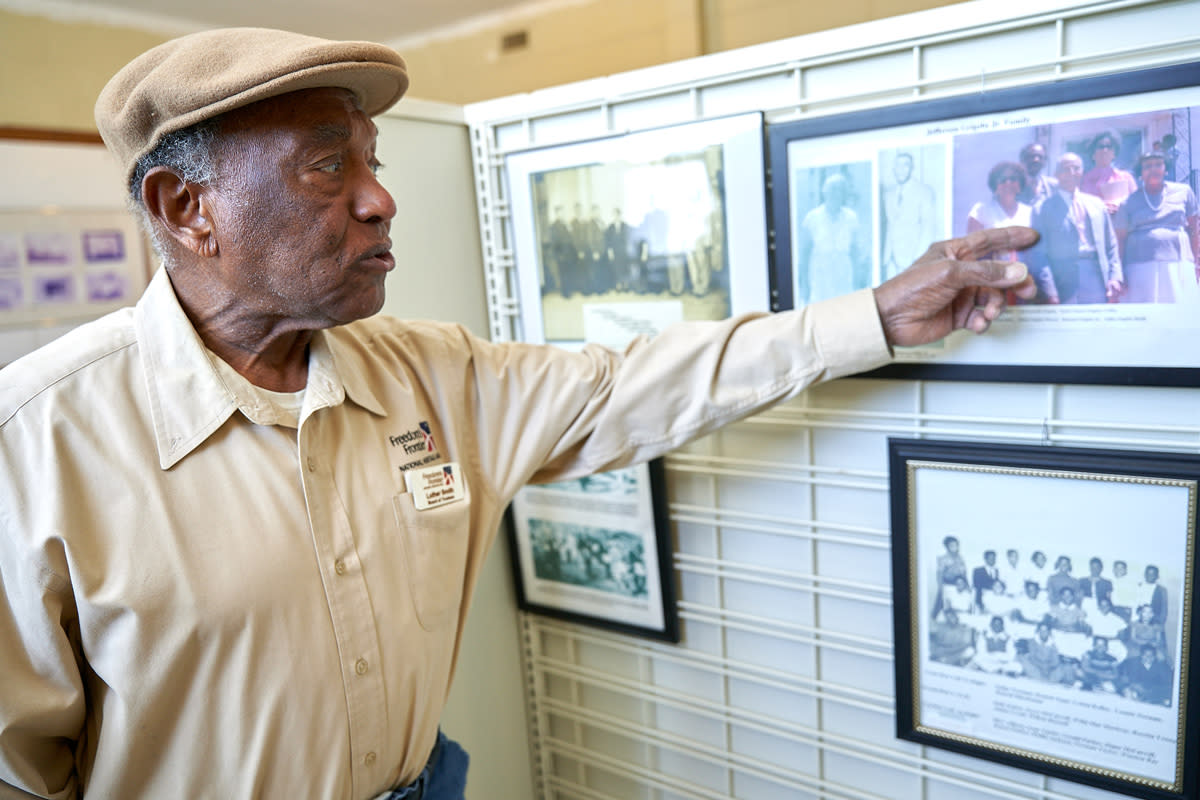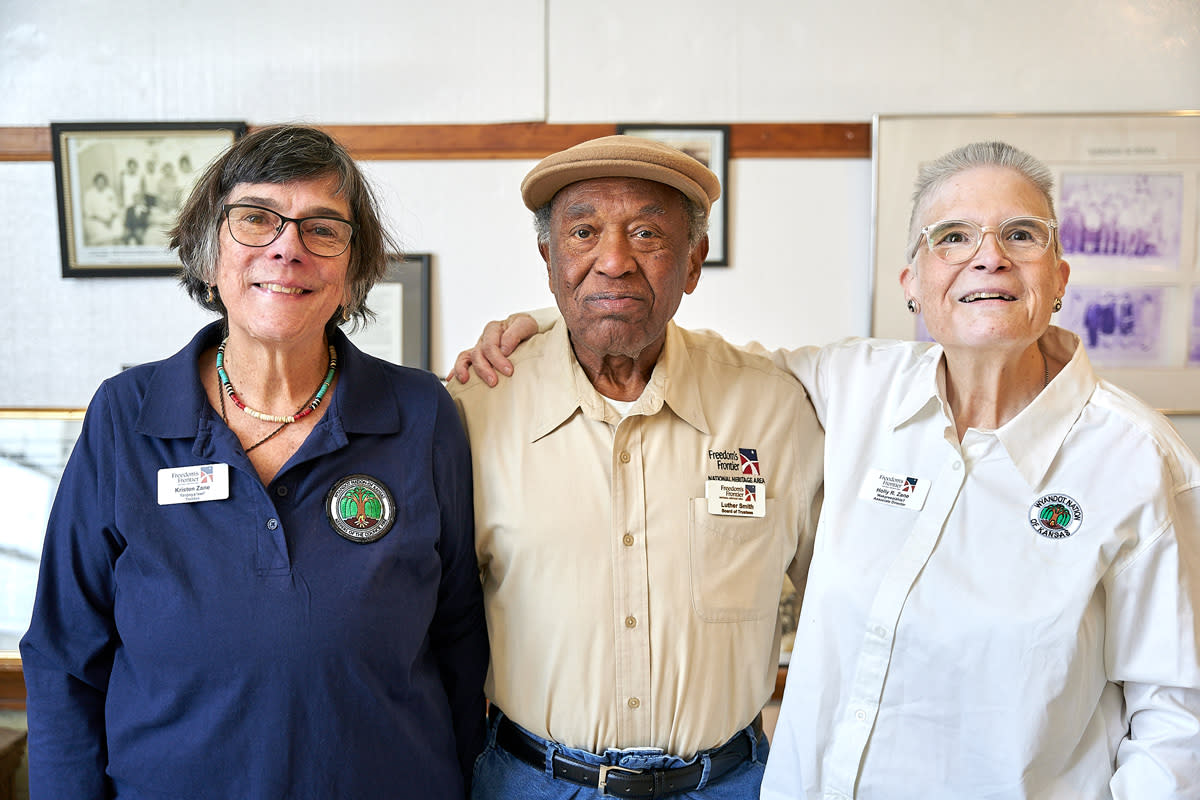 Photography by Andrea LaRayne Etzel & Carter Gaskins
Photography by Andrea LaRayne Etzel & Carter Gaskins
Quindaro was an abolitionist frontier city founded by Indigenous people and strengthened by those who escaped slavery—now, a new generation works to restore and preserve its history
In 1843, when the Wyandot Nation (Waⁿdát or Wandat) was forced to move from upper Ohio to the Kansas Territory, the displaced people took their strong stand against slavery with them when they chose land near the confluence of the Kansas and Missouri Rivers. Here, the nation harbored those who ferried or swam their way out of Missouri and into a land that recognized them as free.
What does the word Quindaro mean?
Pronounced “quin-dare-oh,” it means “bundle of sticks” in the Wandat language. The meaning, explains Wyandot Nation of Kansas enrolled citizen Holly Zane, is “strength in numbers,” and represented the individuals of Quindaro all working toward the common goal of freedom.
By 1850, the Wyandot had formed the settlement of Quindaro. It quickly became a haven for refugees from slave states and continued as such after the federal government disbanded the tribe; abolitionists and Wyandot members who remained in the area founded the town of Quindaro in 1856. At the time, it was the only free-state river port of entry into the Kansas Territory.
Riverboat traffic into Quindaro became heavy, and the famed steamboat Arabia (which has its own museum in Kansas City, Missouri) sank with a shipment full of goods for the growing town. Quindaro grew into a bustling area where Indigenous people, white abolitionists and freed men and women all lived, worked and attended school, living mostly integrated lives. However, there were two Quindaro elementary schools—Quindaro Elementary for white children located at 28th and Farrow, and Vernon Elementary School for Black students at 27th and Sewell.

Generations of Black Settlers
Restoring and commemorating locations such as Quindaro has been the mission of Luther Smith. Since 2008, Smith has been the director of the Old Quindaro Museum in the Vernon Multipurpose Center, formerly Vernon Elementary. Recently, thanks to a National Park Service grant, work has begun to preserve the historic school. “The first thing we need to do is put a roof on the building, and that’s going to take quite a bit of the money,” Smith says.
Though the restoration work is partially funded, the rest of Smith’s labor—as well as the work of those who collaborate with him—is all volunteered.
“When I first took the job, I thought it was going to be a paid position,” Smith laughs. “I’ve put a lot of my own money into that building for the things that really need to be done. But no, I don’t get paid a penny for the work. None of us do.”
Smith, who is now 80, was born in Quindaro. He has fond memories of playing baseball in Quindaro Park and basketball on the elementary grounds. Smith’s mother’s people, the Grigsby family, were some of the original inhabitants of the town of Quindaro. His mother was born in Quindaro in 1918 and passed away in 2018 at the age of 100.

Smith’s dedication to the historic area goes beyond an interest in family history—he recognizes the historic value of Quindaro and wants it to be preserved for future generations. Vernon Elementary School was part of a complex of educational buildings for African Americans, including Western University, established in 1865 as the first college for Black Americans west of the Mississippi River.
“People came from all over the country to attend that university,” Smith says.
Vernon Elementary took its name from William T. Vernon, who graduated from both Lincoln University in Missouri, as well as Wilberforce University in Ohio. He was appointed head of Western University in 1896 but, after a time, left for a greater calling.
“In 1906, [Theodore] Roosevelt appointed him as register of the Treasury—which is the same as the secretary of Treasury now days—from 1906 to 1912,” Smith says. In addition, Charles Hughes, grandfather of famed American writer Langston Hughes, was president of the Teacher’s College at Western University. Today, about all that’s left of Western University is a statue of John Brown erected in 1911.
Smith has a personal fondness for the Vernon Elementary building and is keeping a close eye on funding as it becomes available to refurbish the structure. “That’s my baby right now,” he says. “I want to make that school look as good as it did when it was first built.”
Indigenous Connections
Holly Zane is the associate director of Freedom’s Frontier, an organization whose goal is to preserve the history and build awareness of the struggles for freedom in the historical area of the Kansas-Missouri Border War. Those areas include historic Quindaro as well as 41 counties in Missouri and Kansas.
Like Smith, Zane has family connections to Quindaro that go back to the 1840s. An enrolled citizen with the Wyandot Nation of Kansas, her family’s connections to the region go back to the 1840s when the Wyandot were forced out of Ohio to relocate in Kansas.
“The first thing we did, even before we had land in Kansas as a council, was to declare slavery illegal,” Zane explains.
The Wyandot were abolitionists in Ohio, a conviction that dates to their first encounter with chattel slavery as different, independent tribes living around the St. Lawrence River and Upper Great Lakes region in the mid-1600s. When the people were forced to relocate to Kansas, they traveled with allied peoples who lived among them. “African Americans came south with us,” Zane says.
As the United States slid toward the Civil War and violence erupted in Bleeding Kansas, the fate of these neighboring people was largely intertwined.

“When the United States government broke up our [Kansas] reservation with the Treaty of 1855, it put our African American neighbors and tribal members—anybody who had sought refuge on our reservation—in jeopardy,” Zane says.
Zane’s great-great-grandparents, Ebenezer and Rebecca Zane, operated the Wyandot House Hotel, which welcomed those escaping slavery. Before Emancipation, Quindaro became a significant stop on the Underground Railroad.
“Mainly they would come over from Parkville, Missouri, and get across the river either by ferry, or swimming, which was very dangerous,” Zane explains.
She says tribal members in Quindaro would assist escapees to travel further north, even to Canada, to guarantee their freedom.
The Treaty of 1855 intended to dissolve the Wyandot tribe and forced the Wyandot to cede the land to the federal government, which then assigned parcels to specific Wyandot individuals. Zane’s great-great grandparents, as well as other tribal members, sold their allotments to start the towns of Wyandotte and Quindaro. “All of Wyandotte County was our reservation until the breaking up of the individual allotments,” Zane says.
The US government eventually re-recognized the Wyandot people as a nation, but only one branch. The Canadian government recognizes four Wyandot tribes: the Wyandotte Nation of Oklahoma, the Wyandot of Anderdon Nation in Michigan, the Huron-Wendat Nation, and the Wyandot Nation of Kansas. Now, the tribes hold almost no title to the land their ancestors established as a refuge of freedom for themselves and others. The only part of the land currently partially controlled by Wyandot is the Seventh Street Casino, held in trust by the US government for the Wyandotte Nation of Oklahoma, and the Wyandott Cemetery, held in trust by the US government for the Wyandotte Nation of Oklahoma and the Wyandot Nation of Kansas.

Time and Ruins
Thanks to dedicated individuals and activists such as Smith and Zane, as well as to historians and Kansas politicians from both sides of the aisle, Quindaro was granted National Commemorative Site status in 2019. Eventually, the goal is that Quindaro becomes a destination-worthy National Historic Landmark within the National Park Service, which would mean the site could access grants through the Historic Preservation Fund.
For now, historians and volunteers are concentrating on preserving what can be preserved and spreading the word about the area’s unique and vital history.
“Time has not been good to the ruins,” Zane says.
She and others would like to see a Smithsonian-quality museum built on the site to combine the smaller museums currently there while the remaining historic buildings are properly identified and preserved.
“We’d like all that history to be told,” Zane says.




